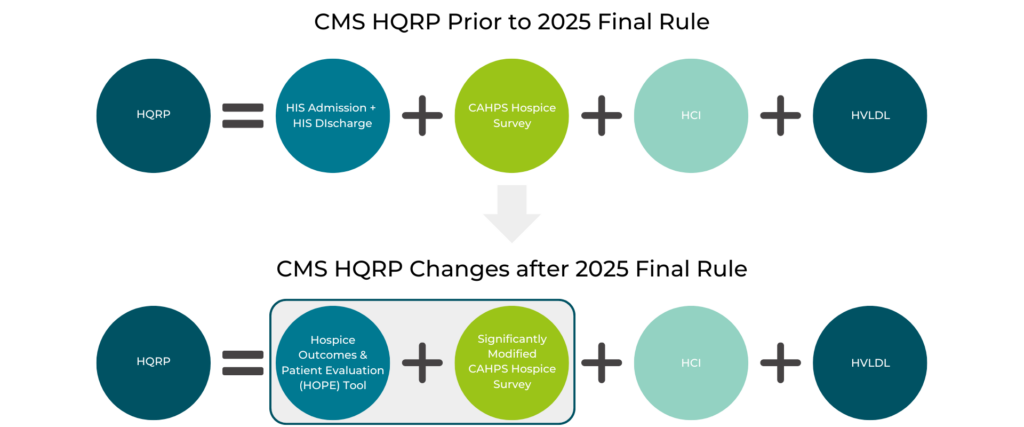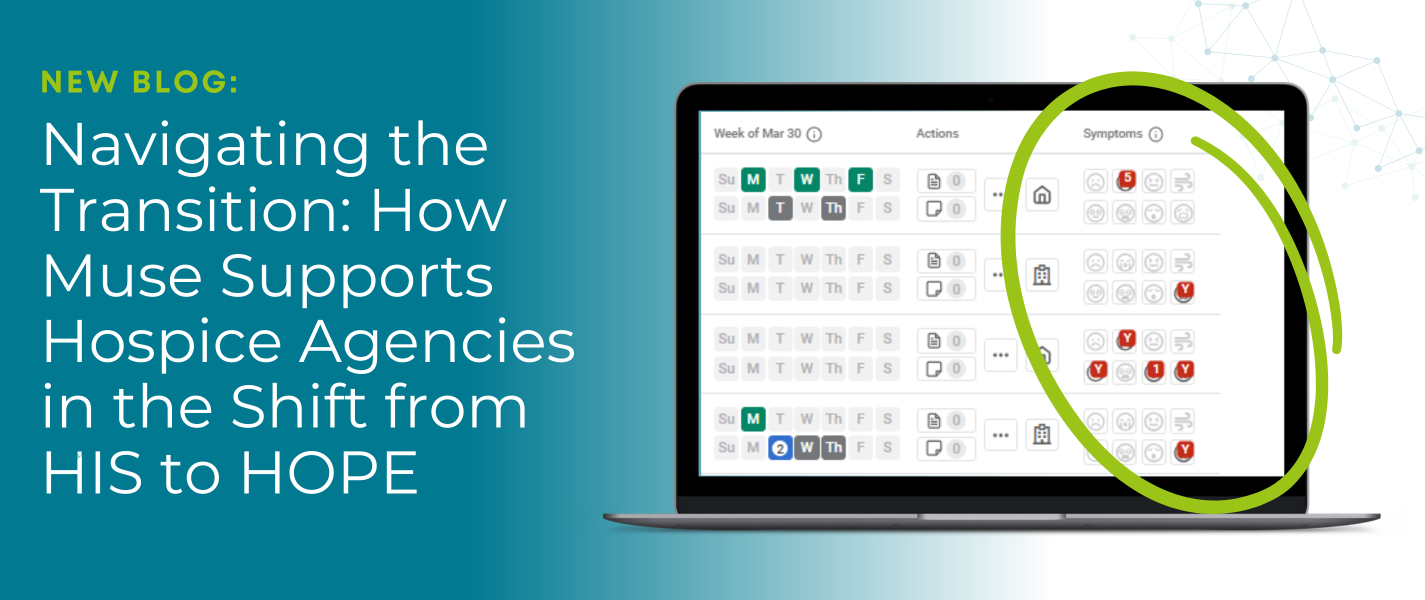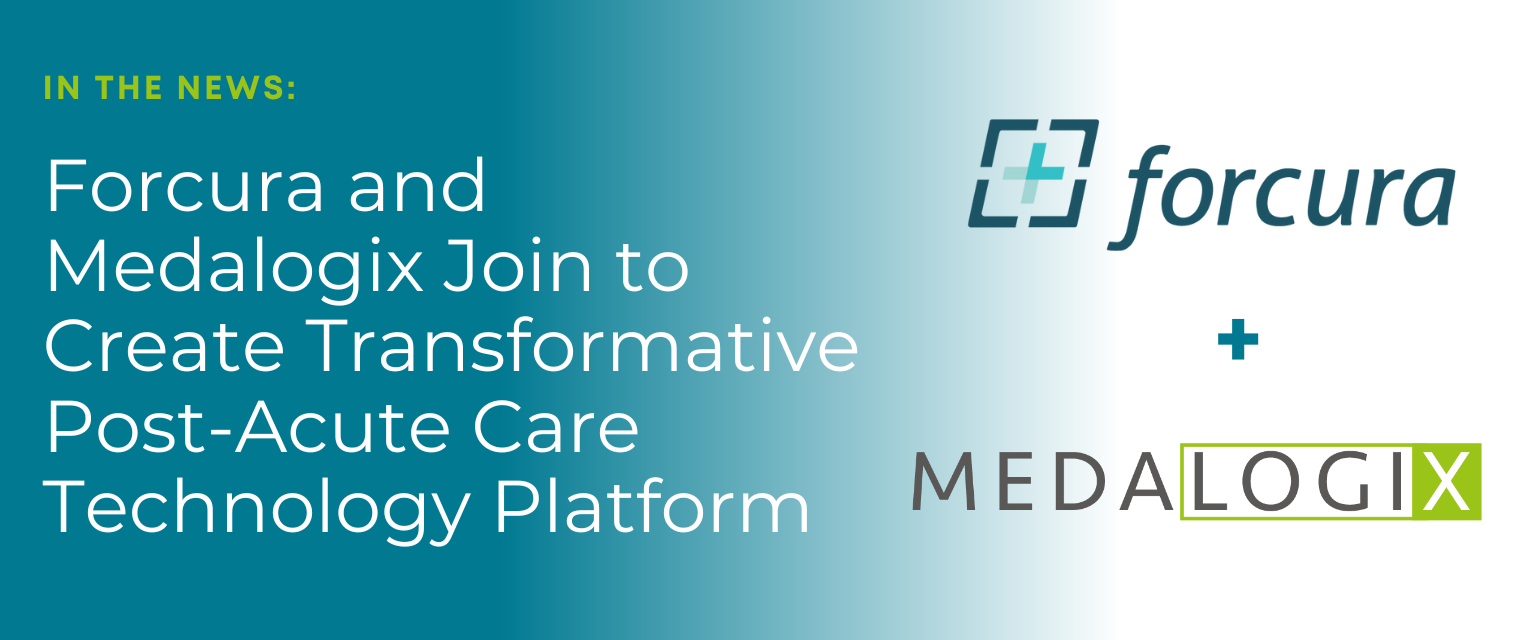CY2025 Hospice Final Rule presents challenges, opportunities for agencies
The CMS 2025 Hospice Final Rule furthers CMS’s multiyear trajectory towards a more pronounced and targeted focus on quality, while also making payment updates that underscore the need for efficient allocation of staff and utilization more broadly. HQRP changes (e.g. HOPE implementation; timely follow-up measures) expand data gathering throughout the patient’s hospice stay and necessitate care coordination that is consistently and quickly responsive to changes in patient condition and needs. Agencies can most successfully respond to CMS’s changes by applying predictive analytics in support of better, more timely care decisions.
Changes brought by the latest CMS final rule are a continuation of multiyear trends
With the 2025 Hospice Final Rule, the Centers for Medicare and Medicaid Services (CMS) take further steps to increase and refine the hospice industry’s focus on quality, while also continuing a trend of relatively minimal payment increases. Both trends together drive an ongoing and increasingly pronounced need for patient-focused and efficient utilization, as well as timely action on changes in patient condition. Hospice agencies can best meet this need by leveraging the right technologies to direct resources where they’re most needed. Let’s dive a bit deeper into some of the changes brought by the final rule and the challenges each poses to hospice agencies:
Payment changes do little to alleviate longstanding financial headwinds
The CY2025 hospice payment update is a net increase of 2.9%, which should result in approximately $790 million in additional payments over 2024. This net update is composed of a 3.4% market increase minus a 0.5% productivity adjustment. While the updated payment rate does acknowledge operational and financial challenges faced by hospice providers, it does not obviate the need for careful resource and staffing utilization management. In many markets, staffing and other costs continue to grow more quickly than do CMS’s payments, increasing pressure on already narrow margins. The annual per patient hospice payment cap has also increased to $34,465.34 for FY 2025. Again, this cap change doesn’t meaningfully relieve financial challenges for hospice agencies, particularly against recent inflation levels.
In addition to payment increases, the CY2025 Final Rule also sees CMS adopt the latest Office of Management and Budget (OMB) statistical area designations. Depending on geography, this may result in payment reductions to agencies. To prevent too steep a drop in payments, there is a permanent maximum 5% reduction to geographic wage indices. While this limitation does offer some stability and predictability in wage adjustments, the impact of any payment reduction will still be palpable. Especially in LCOL areas, agencies that experience payment cuts will face further financial headwinds as compared to 2024.
Now more than ever, hospice agencies need to make the most of the staff and resources they have to match care planning to patient condition and respond to risk in a timely manner. With thin margins growing thinner still, clinically appropriate maximization of payments will be imperative to long-term agency sustainability. The difficulty lies in consistent, thorough, actionable review of every patient record, which is increasingly difficult to do manually. Predictive analytics are essential to cutting through the noise and finding actionable insights that drive alignment between utilization and patient condition, optimal care planning, and improved financial performance. Medalogix offers breakthrough predictive analytics solutions across the home health and hospice spectrum, including the transition points between these care settings.
Updates to the Hospice Quality Reporting Program further refine patient- and quality-focused care.

Beyond changes to payment rates and caps, the final rule also includes adjustments to the composition of the Hospice Quality Reporting Program (HQRP). First, the Hospice Item Set (HIS) will be replaced by the Hospice Outcomes and Patient Evaluation (HOPE), beginning in October 2025. HOPE will collect patient-level data at multiple points across a patient’s hospice stay, including admission, updates, and discharge. This contrasts with HIS, which only collects data at admission and discharge.
The HOPE data collection expansion will cover new areas intended to improve understanding of the patient experience:
- Sociodemographic Information (updated)
- Expanded Diagnoses
- Symptom Impact Assessment
- Skin Conditions
- Imminent Death Indicators
HOPE will also add two specific new process measures to the HQRP: Timely Follow-up for Pain Impact and Timely Follow-up for Non-Pain Symptom Impact. While these measures will not be tracked until FY 2028, they will require follow-up visits within 48 hours of an assessment revealing moderate or severe symptom impact, and agencies should prepare now for consistently timely response to these symptom changes.
Because these changes increase the frequency of data collection and specifically require timely intervention, hospice teams can best set themselves up for success by partnering with the right software. Once again, Muse is an essential partner in driving responsiveness to changes in patient condition and optimizing utilization to reflect each patient’s latest challenges. Where worsened acuity has a long-term impact, Muse helps ensure ongoing adaptation in care planning. By diving deep into the patient record to continuously review structured and unstructured data, Muse surfaces actionable insights that point care teams right where their attention is most needed.
In addition to its impact on care planning improvements, Muse is purpose built to help agencies achieve strong quality reporting performance, with specific functionality around several HCI elements, HVLDL, revocation risk, and other elements that impact quality scores. If there’s one thing the industry can count on, it’s further change. For example, CMS will begin exploring Social Determinants of Health (SDOH) and health equity as potential future data inclusions. Public feedback on potential data like housing instability, food insecurity, and transportation challenges will help determine what future measures and reporting in this area will look like. Regardless of what the future holds in changes to quality measures, Medalogix constantly monitors changes in CMS rules and requirements for future product needs.
Medalogix is a proven partner in improving the utilization, quality, and financial outlook for hospice agencies.
Taken together, these changes are intended to improve care provision behaviors that improve patient outcomes and ensure equity. Despite the positive intent behind them, however, hospice agencies yet again face the expectation to do more than ever to provide quality care on ever-tighter margins. As the hospice landscape continues to evolve towards value-based care while facing an ongoing staffing shortage, partnering with the right technologies is crucial for maintaining compliance and delivering high-quality care. Medalogix has a proven track record of driving improved patient and agency outcomes and quality reporting performance. By applying breakthrough data science, Medalogix brings essential predictive analytics to the hospice space that optimize efficiency, utilization, and outcomes in an increasingly challenging financial climate.
Muse has been built with the understanding that value-based care is the future of hospice, and as such, it contains a wealth of features that help hospice teams respond to changes in patient condition for quality care. It also optimizes utilization by aligning with patient risk and appropriately concentrating visits on patients closer to transition. Muse also gives agencies direct visibility into elements that contribute to HCI and HVLDL. Beyond identifying patients in need of further action, Muse helps free up the capacity to follow through by presenting likely overutilization for lower-risk patients. While some visits saved by appropriate reductions in low-risk utilization can be reallocated to higher-risk patients, including end of life visits, others can be saved entirely.
Diverse clients across the US have found consistent success in patient care, quality, and financial outcomes while using Muse. For example, performance on quality measures far outpaces national averages: On average, Muse clients perform about 45% better on HVLDL than the national benchmark, with improvements in some instances as high as approximately 89% more patients meeting HVLDL visits. Today, Muse assists with managing approximately 20% of all Medicare Hospice patients. In 2023, clients leveraging Muse added an additional 450,282 cinically appropriate visits during the last 7 days of life.
To learn more about what Muse can do for your agency and schedule a demo, visit our Muse page!
Related Blogs

Navigating Homecare’s Persistent Challenges with Technology-Driven Solutions
Authored by: Amanda Fabozzi, PT, DPT, Director of Clinical Services ...

Navigating the Transition: How Medalogix Muse Supports Hospice Agencies in the Shift from HIS to HOPE
Authored by: Steven Shelton, MBA, MSN, RN, CHPN; Senior Director, Clinic...

Forcura and Medalogix Join to Create Transformative Post-Acute Care Technology Platform
Berkshire Partners Will Serve as Lead Investor in the New Platform, with...


